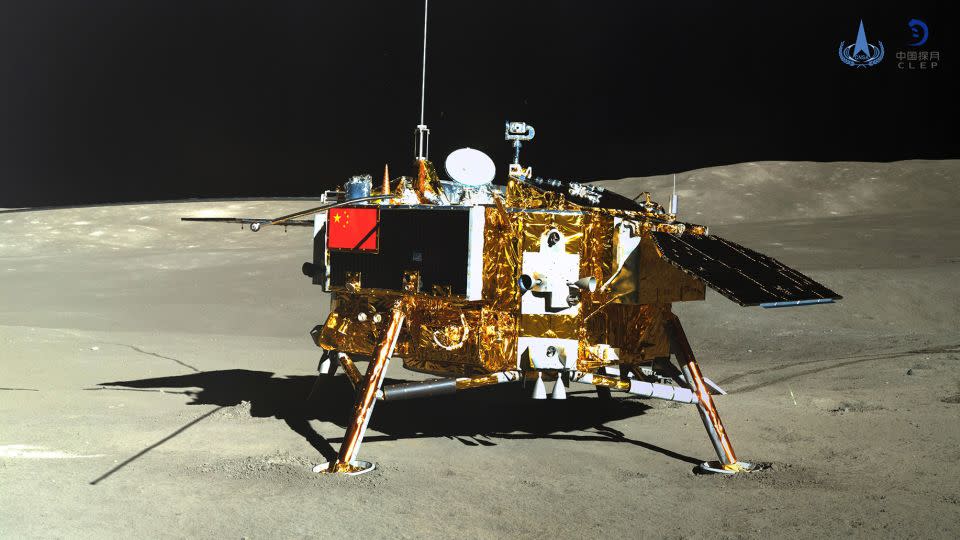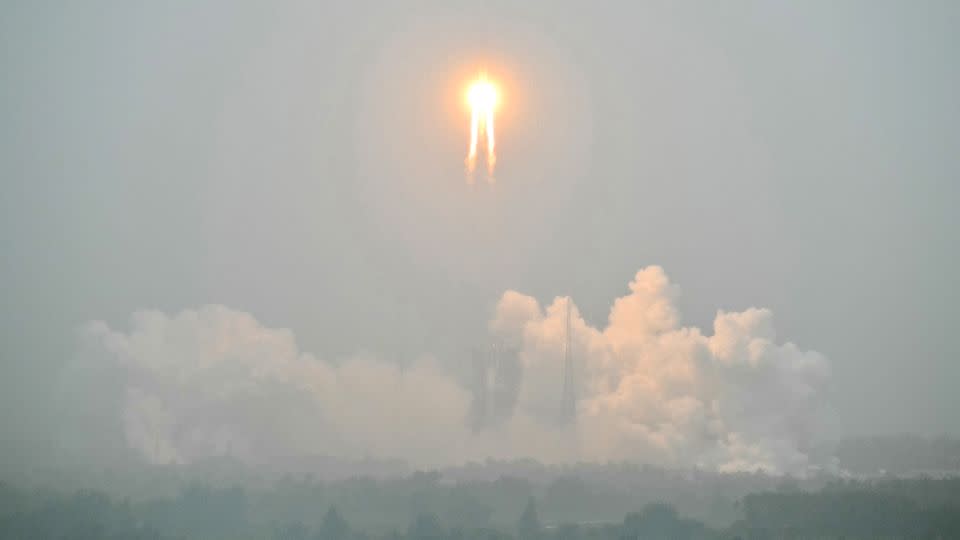Sign up for CNN’s Wonder Theory science newsletter. Explore the universe with news about fascinating discoveries, scientific advancements and more.
When the Chang’e-4 mission touched down in the Von Karman crater on January 3, 2019, China became the first and only country to land on the far side of the moon, the side that is not always facing Earth.
Now China is sending another mission to the far side, and this time its goal is to return the first samples of the “hidden side” of the Moon to Earth.
The Chang’e-6 mission, launched on Friday, will spend 53 days exploring the South Pole-Aitken basin to study its geology and topography and collect samples from different points in the crater.
The South Pole-Aitken basin is believed to be the largest and oldest crater on the moon, covering nearly a quarter of the lunar surface and having a diameter of approximately 1,550 miles (2,500 kilometers). The impact crater is more than 5 miles (8 kilometers) deep.
Scientists hope sending samples back to Earth will help answer persistent questions about the intriguing far side, which has not been studied as thoroughly as the near side, and confirm the moon’s origins.
“The far side of the moon is very different from the near side,” said Li Chunlai, deputy chief designer of the China National Space Administration. “The far side is composed primarily of ancient lunar crust and mountainous regions, so there are a lot of scientific questions to be answered there.”
There is no real ‘dark side’
During a NASA budget hearing on April 17, Congressman David Trone asked NASA administrator Bill Nelson why China was sending a mission to the “back side” of the moon.
“They’re going to make a landing on the far side of the moon, which is the side that’s always dark,” Nelson replied. “We don’t plan on going there.”
The hidden side of the Moon is sometimes referred to as the “dark side of the Moon”, largely in reference to Pink Floyd’s 1973 album of the same name.
But according to experts, this phrase is a bit of a misnomer for a few reasons.
Although the far side of the Moon appears dark to us, just like its near side, it experiences lunar day and lunar night and receives plenty of light. A lunar day lasts just over 29 days, while a lunar night lasts about two weeks, according to NASA.
Since the Moon takes the same amount of time to complete its orbit as the Earth and rotate on its axis, the same side always faces the Earth: about 27 days.
Additionally, the far side of the Moon is more difficult to study, giving rise to the nickname “dark side” and creating an air of mystery.
“People always want to know what’s on the other side of the mountain and the part you can’t see, so it’s a kind of psychological motivation,” said Renu Malhotra, the Louise Foucar Marshall Research Professor of Science and Regents Professor of Planetary Sciences. at the University of Arizona in Tucson. “Of course, we’ve sent spacecraft into orbit around the moon and we have images, so in a way it’s less mysterious than it was before.”
Many spacecraft have helped shed light on the moon, including NASA’s Lunar Reconnaissance Orbiter, which constantly orbits and captures images of the lunar surface.
Yutu-2, a lunar rover that Chang’e-4 launched in 2019, also explored loose deposits of pulverized rock and dust littering the floor of the Von Karman crater, located in the larger South Pole-Aitken basin.

But returning the samples to Earth would allow the newest, most sensitive technology to be used to analyze rocks and dust on the Moon, potentially revealing how the Moon came to be and why its far side is so different from the near side.
Mysteries on the far side
Despite years of orbital data and samples collected during the six Apollo missions, scientists are still trying to answer important questions about the moon.
“The reason the far side is so interesting is that it’s very different from what we see from the near side of the moon,” said Noah Petro, NASA’s project scientist for both Lunar Orbiter Reconnaissance and Artemis III. It aims to land humans on the moon for the first time since 1972. “Throughout human history, people have been able to see the same surface, the same face of the moon.”
But in 1959, the Soviet Union sent a probe to fly to the far side of the moon and capture humanity’s first images of it.
“We saw a completely different hemisphere: not covered in huge volcanic lava flows, but a thicker crust full of craters. “It just tells a different story from the near side,” Petro said.
Returning samples by robotic missions and landing humans near the transition between two lunar regions at the south pole through the Artemis program “will help tell this more comprehensive story of lunar history that we’re missing right now,” he said.
Although scientists understand why one side of the moon always faces Earth, they don’t know why that side always faces our planet. However, Malhotra said this may have something to do with the moon being asymmetrical.
“There is an asymmetry between the other side and the other side,” he said. “What exactly caused these asymmetries? What actually are these asymmetries? We have little understanding of this. “This is a huge scientific question.”
Planetary geologist Brett Denevi of the Johns Hopkins University Applied Physics Laboratory said orbital data revealed that the near side had a thinner crust and more volcanic accumulation, but why this eluded researchers.
“It has a different kind of geochemical composition, with some weird extra heat-producing elements. There are tons of models for why the near side is different from the far side, but we don’t have data yet,” Denevi said. “So going to the far side, taking samples and doing different types of geophysical measurements is really important to solving this long-standing mystery.”


Chang’e-6 is just one of the missions heading to the far side of the Moon, as NASA plans to send robotic missions there as well.
Denevi helped design a mission concept for a lunar rover called Endurance; This vehicle will make a long journey through the South Pole-Aitken basin, collecting data and samples before delivering them to the Artemis landing sites near the moon’s south pole. Astronauts can then examine the samples to determine which ones will return to Earth.
cracking the moon code
One of the most fundamental questions that scientists are trying to answer is how the moon was formed. The prevailing theory is that some kind of object hit the Earth early in its history, and a giant piece that flew away from our planet formed the Moon.
Scientists also want to know how the original crust of the moon formed.
Volcanic flows create dark spots on the moon, while the lighter parts of the surface represent the moon’s primitive crust.
“We think that at some point the Moon was completely molten and there was this ocean of magma, and as it solidified the minerals floated to the top of this ocean and this is the lighter terrain that we can see today,” Denevi said. “Getting to the really large, unspoiled lands on the far side is just one of the goals.”
Meanwhile, studying the impact craters that litter the lunar surface provides a history of how objects moved in the early days of the solar system, at a critical point when life began to form on Earth, Denevi said.
“Just as there were coups on the Moon, there were also coups on Earth,” Petro said. “And every time we look at these ancient events on the Moon, we also learn a little bit about what’s going on on Earth.”
Visiting the South Pole-Aitken basin could be the beginning of solving many lunar mysteries, Malhotra said. While researchers believe they have an idea of when the crater formed (perhaps between 4.3 and 4.4 billion years ago), collecting rock samples can provide an exact age.
“Many scientists are confident that if we can figure out the age of this depression, we will unlock all kinds of mysteries about the history of the moon,” he said.
CNN’s Wayne Chang contributed to this report.
For more CNN news and newsletters, create an account at CNN.com